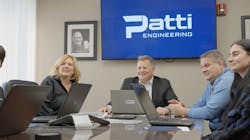Patti Engineering depends on data to guide design
Patti Engineering, a system integrator with offices in Michigan, Texas and Indiana, employs 32 workers, including 23 electrical and two mechanical engineers. The company typically integrates full systems, involving machining cells, robotics, conveyors or motion systems, executing between 80 and 100 custom projects per year.
Typical project timelines from design stage to installation run 16 to 20 weeks, but oftentimes manufacturers must minimize downtown for installation. Patti Engineering recently completed a Siemens controls upgrade for a customer in the heavy equipment industry that produces engine blocks. It took the manufacturer 90 days of overtime to build enough stock to be able to shut down for one week, so the commitment to the timeline was critical.
“The upgrade was needed because the previous system was obsolete and obtaining repair parts was no longer possible. Four controllers were originally being used, which was reduced to a single controller,” says Sam Hoff, CEO and president of Patti Engineering.
A crew working 24/7, superior project management and virtual commissioning of the software made the project possible on such a short timeline, he says. For virtual commissioning, Patti Engineering used Siemens PLCSIM Advanced to understand how the logic was performing, eliminating troubleshooting in the field.
“We provided functional specifications, telling the customer exactly how we're going to design the system,” Hoff says. He credits good communication and upfront planning as key to time-critical projects.
“Many integrators and companies will shy away from controls upgrades because they are inherently risky. But an end user can spend pennies on the dollar and get a successful upgrade. In our experience, thoroughly researched solutions and project management eliminate the inherent risk,” he adds. It’s also important to consider the experience level of those that are using both the legacy and new control systems, Hoff says.
Digitalization, diagnostics, data integration, robotics and giving clients the ability to run equipment with less local expertise and a smaller workforce, Hoff says, are important trends affecting Patti Engineering customers and their machines.
“The data, as well as the monitoring process on the edge and cloud, are always factors in the upfront design. Using the data from previous designs helps you improve future iterations, which inevitably changes the way we look toward the future,” Hoff says. Edge and cloud technologies for collecting real-time data and storing historical data, respectively, are integral for industrial systems to run with less local support.
Patti Engineering leverages the Siemens NX and Tecnomatix software platforms to do simulations, virtual commissioning and maintaining of a digital twin for the physical system.
“We feel that far too little attention is paid to diagnostics, data strategy and the total life cycle management of an integrated system,” Hoff adds. The diagnostics from previous designs can pinpoint areas to enhance reliability, fault tolerance, predictive maintenance, safety, efficiency and performance optimization, he adds (Figure 1).
“End users should absolutely consider total lifecycle management. I see a lot of mechanical systems that are prematurely discarded. Absolutely, take a lifecycle management approach on your controls from the beginning,” Hoff says.
The supply chain has challenged upfront engineering on projects, and, when parts aren’t available, designers are forced to look for substitutes, which can affect the project schedule. “However, we feel that we are starting to see a light at the end of the tunnel and are seeing fewer effects of the global supply chain issues as time goes on,” Hoff says.
Collaborative robot integration
This is one of the first collaborative robots using the line tracking for unloading a high-speed conveyor, he says. “The objects were floating in space, so vision was used to fine tune the adjustment of the gripping of the object in real time,” Hoff says. “Fanuc 2D iRVision was used to verify open placement locations on the sample cart for the robot to load to. We also used Fanuc Line Tracking to enable the robot to pick up the bottle off the moving conveyor.”
Patti Engineering also developed a human-machine interface (HMI) to select the correct height for the bottle pick position and communicate with the manufacturer’s programmable logic controller (PLC) in order to select which mold cavity would be sampled off the conveyor.
Component vendor preferences
Patti Engineering works mainly in the United States in the automotive, heavy equipment, food-and-beverage, pharmaceutical and warehouse/logistics industries. The company’s core partners are Siemens, Fanuc, Inductive Automation, Mitsubishi Electric Automation and Beckhoff.
“We work with our clients to mutually choose the best supplier for their control components. We will integrate suppliers that are not our partners for a client in certain instances,” Hoff says. Patti Engineering preferred vendors for PLCs, programmable automation controllers (PACs), industrial PCs and control software are Siemens, Mitsubishi and Beckhoff. For motion components, the company prefers Siemens, Mitsubishi Electric Automation, Fanuc and Bosch Rexroth. Patti Engineering is vendor-agnostic on sensing equipment, enclosures and safety components (Figure 3). For communication protocols, the company’s preference is message queuing telemetry transport (MQTT), and, for display components, it relies on Siemens and Mitsubishi Electric Automation.
About the Author
Anna Townshend
Managing Editor
Anna Townshend has been a writer and journalist for 20 years. Previously, she was the editor of Marina Dock Age and International Dredging Review, until she joined Endeavor Business Media in June 2020. She is the managing editor of Control Design and Plant Services.

Leaders relevant to this article:



